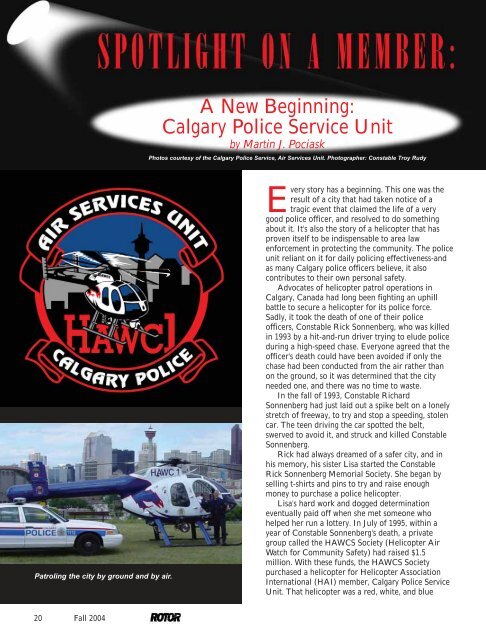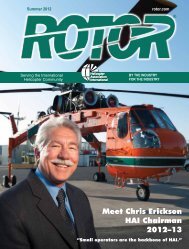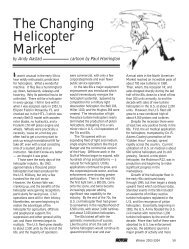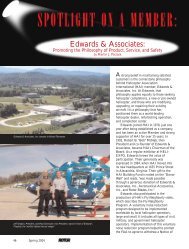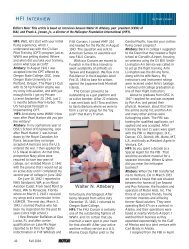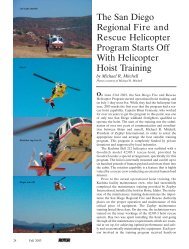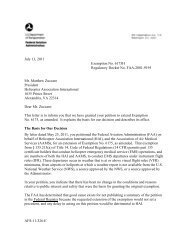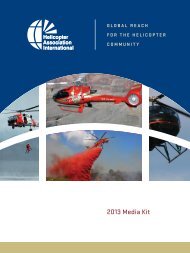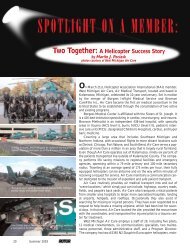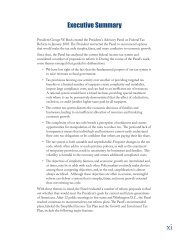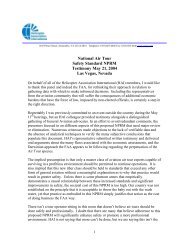A New Beginning: Calgary Police Service Unit - Helicopter ...
A New Beginning: Calgary Police Service Unit - Helicopter ...
A New Beginning: Calgary Police Service Unit - Helicopter ...
You also want an ePaper? Increase the reach of your titles
YUMPU automatically turns print PDFs into web optimized ePapers that Google loves.
A <strong>New</strong> <strong>Beginning</strong>:<br />
<strong>Calgary</strong> <strong>Police</strong> <strong>Service</strong> <strong>Unit</strong><br />
by Martin J. Pociask<br />
Photos courtesy of the <strong>Calgary</strong> <strong>Police</strong> <strong>Service</strong>, Air <strong>Service</strong>s <strong>Unit</strong>. Photographer: Constable Troy Rudy<br />
Patroling the city by ground and by air.<br />
Every story has a beginning. This one was the<br />
result of a city that had taken notice of a<br />
tragic event that claimed the life of a very<br />
good police officer, and resolved to do something<br />
about it. It's also the story of a helicopter that has<br />
proven itself to be indispensable to area law<br />
enforcement in protecting the community. The police<br />
unit reliant on it for daily policing effectiveness-and<br />
as many <strong>Calgary</strong> police officers believe, it also<br />
contributes to their own personal safety.<br />
Advocates of helicopter patrol operations in<br />
<strong>Calgary</strong>, Canada had long been fighting an uphill<br />
battle to secure a helicopter for its police force.<br />
Sadly, it took the death of one of their police<br />
officers, Constable Rick Sonnenberg, who was killed<br />
in 1993 by a hit-and-run driver trying to elude police<br />
during a high-speed chase. Everyone agreed that the<br />
officer's death could have been avoided if only the<br />
chase had been conducted from the air rather than<br />
on the ground, so it was determined that the city<br />
needed one, and there was no time to waste.<br />
In the fall of 1993, Constable Richard<br />
Sonnenberg had just laid out a spike belt on a lonely<br />
stretch of freeway, to try and stop a speeding, stolen<br />
car. The teen driving the car spotted the belt,<br />
swerved to avoid it, and struck and killed Constable<br />
Sonnenberg.<br />
Rick had always dreamed of a safer city, and in<br />
his memory, his sister Lisa started the Constable<br />
Rick Sonnenberg Memorial Society. She began by<br />
selling t-shirts and pins to try and raise enough<br />
money to purchase a police helicopter.<br />
Lisa's hard work and dogged determination<br />
eventually paid off when she met someone who<br />
helped her run a lottery. In July of 1995, within a<br />
year of Constable Sonnenberg's death, a private<br />
group called the HAWCS Society (<strong>Helicopter</strong> Air<br />
Watch for Community Safety) had raised $1.5<br />
million. With these funds, the HAWCS Society<br />
purchased a helicopter for <strong>Helicopter</strong> Association<br />
International (HAI) member, <strong>Calgary</strong> <strong>Police</strong> <strong>Service</strong><br />
<strong>Unit</strong>. That helicopter was a red, white, and blue<br />
20 Fall 2004
McDonnell Douglas (MD) 500N<br />
helicopter, which was dubbed<br />
HAWC1. That event marked a<br />
turning point; it established the<br />
<strong>Calgary</strong> <strong>Police</strong> <strong>Service</strong>s <strong>Unit</strong> as the<br />
first municipal police air service unit<br />
in Canada and the acquisition of a<br />
full-time patrol helicopter. The unit<br />
has adopted the hawk as a symbol of<br />
safety, and the aircraft does indeed<br />
have the image of a hawk on it.<br />
Consequently, the HAWC1 has, at<br />
times, also been referred to as<br />
Hawk-1.<br />
The helicopter was put to work<br />
right away, patrolling the 750,000 sq<br />
km area of the city and its population<br />
of around a million people. To<br />
everyone's delight, the helicopter,<br />
flying at 136 mph (220 km/hr), could<br />
quickly cover <strong>Calgary</strong> from one end<br />
of the city to the other in just three<br />
to four minutes! Even more<br />
astounding, the helicopter's average<br />
response time was approximately 90<br />
seconds.<br />
In its first year of operation, the<br />
<strong>Calgary</strong> <strong>Police</strong> <strong>Service</strong>s Air <strong>Service</strong>s<br />
Thousands of children have had the chance to see the HAWC1 up close,<br />
during school visits.<br />
<strong>Unit</strong> clearly demonstrated the<br />
critical need for helicopter patrol by<br />
logging more than 1,000 hours of<br />
helicopter patrol time and assisting<br />
in more than 500 arrests, while<br />
saving lives and preventing property<br />
loss. Their success was noted and<br />
served as a catalyst to help kick-start<br />
discussion by other police units<br />
throughout Canada on the<br />
advantages of aerial police patrol,<br />
and how this aspect of police work<br />
might help to expand their ability to<br />
<strong>Calgary</strong> continued on page 23<br />
Fall 2004<br />
21
The Hilton Anaheim Welcomes HELI-EXPO 2005!<br />
TAKE ME TO THE HILTON. TM<br />
The Hilton Anaheim is the largest hotel in Anaheim and it offers something for everyone. Just a few<br />
of the amenities include the Executive Floor with exclusive service and a concierge’s lounge with<br />
complimentary breakfast and evening appetizers. For convenience, there are many quality retail<br />
shops and a self service U.S. Post Office. For dining, the Hilton Anaheim offers five restaurants and<br />
lounges, including a brand new Starbucks TM. For fitness and relaxation, guests can enjoy a 25,000<br />
square foot state-of-the-art facility with a complete array of Spa services. The Hilton Anaheim is<br />
located just one block from Disneyland and Disney’s California Adventure.<br />
To make your hotel reservations, please contact the Anaheim Housing Bureau at 714-765-8868, or book on-line at www.rotor.com.
firsthand, by accompanying flight<br />
crews on operational shifts. Public<br />
support is very important to the<br />
unit's mission. The Air <strong>Service</strong>s <strong>Unit</strong><br />
has gone to great lengths to make<br />
the helicopter as accessible as<br />
possible to the public.<br />
As part of their ongoing<br />
commitment to give back to the<br />
community, there have been more<br />
than 350 "fly-along" certificates<br />
given to charitable organizations in<br />
<strong>Calgary</strong>. These are often auctioned<br />
at events, and to date, have raised<br />
more that $300,000 for local<br />
charities. Thousands of local<br />
children have had a<br />
chance to see<br />
HAWC1 up close,<br />
during school visits,<br />
where they land in<br />
the schoolyard and<br />
give a short<br />
presentation.<br />
The HAWC1<br />
has also been<br />
involved in assisting<br />
other City of<br />
<strong>Calgary</strong> departments<br />
covering a variety of<br />
functions and<br />
services, including<br />
aerial photography,<br />
videotaping, disaster<br />
planning, scene<br />
assessment, and<br />
emergency<br />
response. The helicopter and flight<br />
crew have assisted Royal Canadian<br />
Mounted <strong>Police</strong> (RCMP) members<br />
in giving pursuit when, in the course<br />
of events, a crime has been<br />
committed and the perpetrator has<br />
fled the city and has entered into<br />
RCMP's jurisdiction. They have also<br />
assisted ground-based command<br />
personnel during disturbances and<br />
for coverage of public events.<br />
Greg Taylor, Director of<br />
Maintenance for the <strong>Calgary</strong> <strong>Police</strong><br />
<strong>Service</strong>, states, "HAWC1 has helped<br />
change the way we handle vehicle<br />
pursuits. Once a fleeing vehicle is<br />
spotted from the air, ground units<br />
can be moved safely back while<br />
HAWC1 follows from above. With<br />
HAWC1 in action, the apprehension<br />
success rate in pursuits is over 90<br />
percent. When HAWC1 is not<br />
available, the success rate drops to<br />
less than 30 percent. <strong>Calgary</strong> is a<br />
modern city of about one million<br />
people spread out along the foothills<br />
of the Rocky Mountains. Because of<br />
the city's growth, the response time<br />
to a call has slowly increased from<br />
90 seconds to almost two minutes,<br />
but, HAWC1 is still 'first on scene' at<br />
over 60 percent of the calls we are<br />
dispatched to."<br />
The Air <strong>Service</strong>s <strong>Unit</strong> has always<br />
had an exceptionally good working<br />
relationship with the <strong>Calgary</strong> Fire<br />
Department as well as the local<br />
The HAWC1 patrols <strong>Calgary</strong>’s 750,000 sq km area,<br />
protecting its one million citizens.<br />
EMS provider STARS (Shock<br />
Trauma Air Rescue Society).<br />
HAWC1 has provided vital support<br />
to the <strong>Calgary</strong> Fire Department at<br />
several high profile fires in the city.<br />
Taylor proudly points out, "We<br />
have used our "Bambi" bucket at<br />
grass and structure fires. At a very<br />
serious refinery fire the smoke was<br />
so thick and black, the ground crews<br />
could only direct their hose streams<br />
into the smoke and hope they were<br />
doing some good. HAWC1 arrived<br />
and using the FLIR and Downlink<br />
system, we sent real time video to<br />
the fire command bus, and the<br />
captain was able to see that most of<br />
the water was hitting the parking lot,<br />
and have the crews redirect their<br />
streams to hot spots. We have the<br />
only fast water rescue capability of<br />
its kind in Canada. Working with<br />
HAWC1, Aquatic Rescue Team<br />
divers can be placed into fast moving<br />
water or isolated open water to<br />
assist a victim who might otherwise<br />
not be rescued. HAWC1 has assisted<br />
the <strong>Calgary</strong> Fire Department at over<br />
600 separate incidents."<br />
There was of course, a significant<br />
amount of training, necessary for<br />
operational flight safety and to<br />
ensure personnel preparedness.<br />
Regular maintenance is performed<br />
on HAWC1, including daily<br />
inspections, scheduled maintenance,<br />
specialty equipment installations,<br />
and unscheduled<br />
maintenance.<br />
According to<br />
Taylor, "To date we<br />
have logged over ten<br />
thousand hours on<br />
one helicopter, with<br />
no major incidents,<br />
and we were very<br />
proud to receive<br />
HAI's Law<br />
Enforcement Award<br />
in 1996."<br />
The Air <strong>Service</strong>s<br />
<strong>Unit</strong> has been<br />
involved in several<br />
high profile<br />
operations, such as<br />
the G-8 Summit,<br />
which was held at<br />
Nakiska (80 miles<br />
west of <strong>Calgary</strong>), in 2002.<br />
Taylor notes, "This was a very<br />
interesting experience because we<br />
worked with so many different<br />
organizations, including the Royal<br />
Canadian Mounted <strong>Police</strong> (RCMP),<br />
Center for Strategic & International<br />
Studies (CSIS), Federal Bureau of<br />
Investigation (FBI), Central<br />
Intelligence Agency (CIA), and U.S.<br />
Marines with Presidential Security.<br />
This was all happening shortly after<br />
9/11, so security was a very high<br />
priority."<br />
He adds, "We have also assisted<br />
in several life saving operations.<br />
One such incident occurred on a<br />
cold winter night, when we went to<br />
assist STARS at a vehicle roll over<br />
on the edge of the city. We lit up the<br />
scene with the NightSun and STARS<br />
24 Fall 2004
landed on the road at the scene.<br />
They were loading two critically<br />
injured patients, and one of the<br />
victims asked about the fourth<br />
passenger. There were only three<br />
people at the scene. One of the<br />
medical crew asked if we could have<br />
a look around to see if there was a<br />
fourth victim. We FLIRed the area<br />
and found a faint heat source 150<br />
yards from the rollover. We directed<br />
one of the ground medical crew<br />
toward the heat source as STARS<br />
left with the two casualties. After<br />
wading through deep snow and thick<br />
bush, with only a flashlight and<br />
HAWC1's NightSun to see, the EMS<br />
member found the heat source, and<br />
it was the fourth passenger from the<br />
rollover. He had sustained the worst<br />
injuries, but had managed to<br />
wander, in shock, for 150 yards. It<br />
took 30 minutes to get more EMS<br />
members with equipment and a<br />
stretcher to the victim, and extract<br />
him from the bush. We had radioed<br />
STARS to return to the scene after<br />
delivering the first two patients to<br />
the hospital. The helicopter<br />
returned just as the EMS team<br />
emerged from the trees, dragging<br />
the stretcher through the snow.<br />
Talking to the ground crew<br />
afterwards, we found out that this<br />
patient would not have survived,<br />
had he not been found as quickly as<br />
he was. This is an excellent example<br />
of teamwork, between agencies, as<br />
well as between air and ground<br />
crews. We couldn't do our job<br />
without the dedicated people on the<br />
ground doing theirs. After serving<br />
<strong>Calgary</strong> for over nine years, we<br />
recognize that we need another<br />
helicopter, and Lisa Stinson (Rick<br />
Sonnenberg's sister), has completed<br />
another lottery campaign to<br />
purchase our second helicopter,<br />
which will be dubbed HAWC2."<br />
The addition of the helicopter<br />
has brought immediate benefits to<br />
the <strong>Calgary</strong> community. It has saved<br />
time and improved response time.<br />
It has reduced vehicle theft,<br />
resulted in a higher relocation rate,<br />
helped to better ensure officer<br />
safety, aided in more effective<br />
searches, been instrumental in the<br />
reduction of criminal activity,<br />
provided better support and<br />
coverage of disturbances and public<br />
events, assisted fire suppression,<br />
been used to assist outside agencies,<br />
and provided EMS services<br />
following accidents and during<br />
emergency situations when a quick<br />
response or additional support<br />
assistance was necessary.<br />
Members like the <strong>Calgary</strong> <strong>Police</strong><br />
<strong>Service</strong>s <strong>Unit</strong> are proof-positive of<br />
the benefits of the helicopter law<br />
enforcement. Calgarians are<br />
extremely proud of their law<br />
enforcement officers and grateful to<br />
Lisa for her efforts, which made it<br />
possible to purchase the <strong>Calgary</strong><br />
<strong>Police</strong> <strong>Service</strong>s <strong>Unit</strong>'s first<br />
helicopter, and again, played an<br />
instrumental role in raising funds to<br />
purchase a second one.<br />
Martin J. Pociask is director of<br />
communications for HAI.<br />
Fall 2004<br />
25


